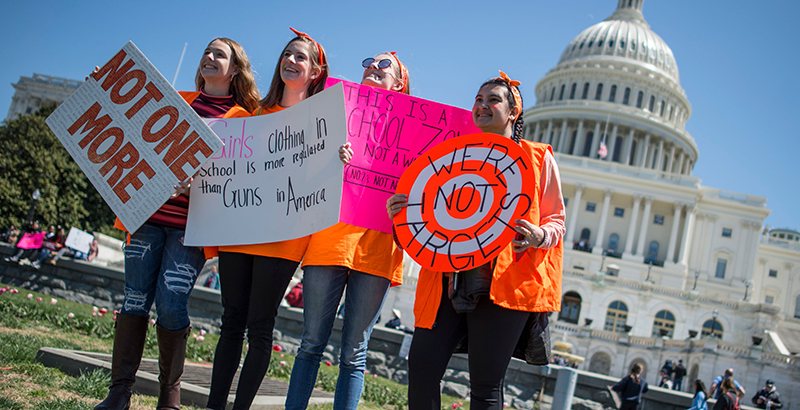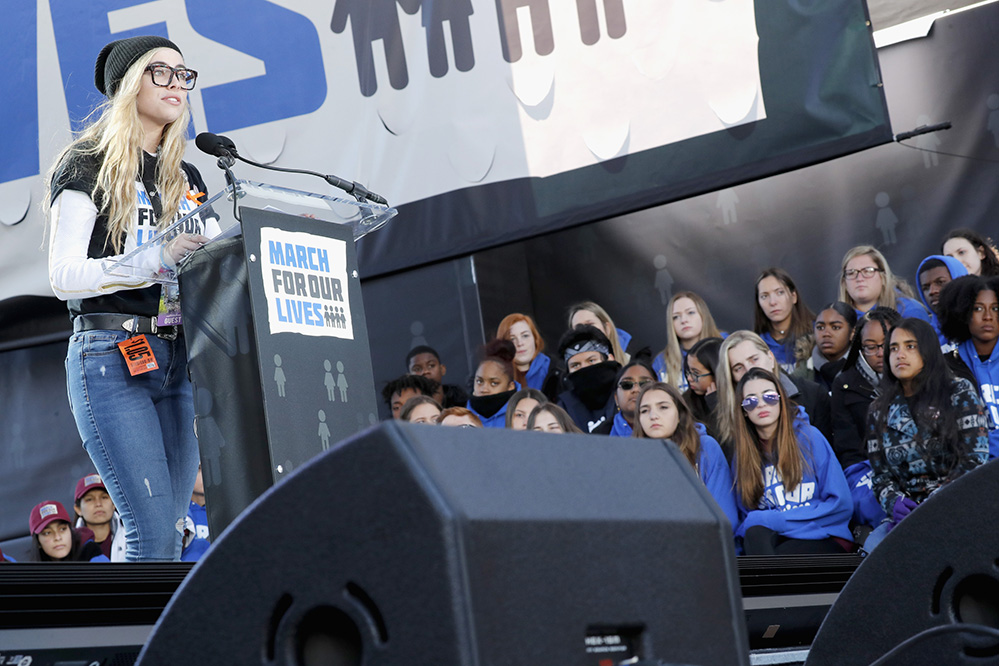Delaying College, Getting Out the Vote: As They Stage Another National Walkout Over Gun Violence, Students Look to Movement’s Sustainability

In Washington, D.C., students fled their classrooms to protest outside the White House. In Iowa, hundreds of students gathered outside the state capitol to demand change. And in Ridgefield, Connecticut, where Friday’s national school walkout originated, student activists began the day with a 13-second moment of silence for the victims of a mass school shooting that riled the nation before they were born.
More than two months after a gunman killed 17 people at Marjory Stoneman Douglas High School in Parkland, Florida — and 19 years after a mass school shooting at Columbine High School in Littleton, Colorado, left 13 people dead — a student-led movement to combat gun violence continues to dominate the American political conversation. On Friday, students from thousands of schools across the country ditched their classrooms in a daylong walkout to mobilize youth voters around gun control.
But Delaney Tarr, a senior at Stoneman Douglas, is looking ahead. Since the rampage at her school on February 14, Tarr has become a leading student voice in the school shooting debate. Since the very beginning, she told The 74, critics warned that their moment in the spotlight would be fleeting. Media attention will wane, they said, new national issues will emerge, and of particular concern as summer approaches, some of the most prominent figures will head off to college.
“People have been telling us from day one that this will fade away, that people will forget about us,” Tarr said. “And they haven’t yet.”
Tarr recognizes what the students are up against. Historically, sustainability has been a top hurdle for the success of social movements, said Peter Levine, who studies youth civic engagement and is the associate dean for research at the Tisch College of Civic Life at Tufts University. However, he said he’s impressed by the Parkland survivors and their allies.
Only time will tell whether the momentum will last, Levine said, but several facets could offer reasons for optimism: a multifaceted approach that includes urging young people to vote and boycotting NRA-sponsored companies, the upcoming midterm elections, their grief.
“The Parkland movement is the most politically mainstream movement I think we’ve seen for a long time,” Levine said. “And they’re making very immediately actionable requests of their participants, like ‘Vote in 2018.’ ”
The emotional toll
Tarr had long dreamed of becoming a broadcast journalist at a major television network. After the rampage, she said, her entire life trajectory changed. Now, she plans to take a gap semester to focus on the movement before studying politics at a university in Washington, D.C. Another vocal Parkland student, David Hogg, also plans to hold off on college to focus on their cause.

“We’re going to all these different high schools, these different events, to connect with students, to connect with young people,” she said. “Of course, we’re still focused on legislation, but what we really need in this moment is to get people caring about the issues.”
Friday’s daylong national school walkout, which reportedly attracted thousands of participants from schools in each U.S. state, is the third nationwide event since the Parkland shooting. In Ridgefield, some 500 high school students staked out the football field.
“This is a new future for America, and regardless if politicians are ready for it, change is happening and they can’t stop time,” Lane Murdock, a Ridgefield sophomore who launched the Friday walkout, told Connecticut Public Radio.
Although it appears Friday’s march was smaller in scale than previous events, it faced opposition from some school leaders. Last month, for example, New York City education officials said they wouldn’t punish students for participating in the March walkout if they returned to class after the demonstration concluded. This time around, however, the city’s new schools chancellor, Richard Carranza, discouraged students from participating. Even at Columbine, students participated in a day of service rather than a walkout.
(Incidentally, a few hours before the national walkout kicked off, Florida experienced another school shooting. Friday morning, a student was shot in the ankle at Forest High School in Ocala, Florida. The suspect was taken into custody, and the victim’s injury was not life-threatening.)
In order to spur reforms they believe could combat similar tragedies, Tarr contends, generating local, grassroots support is key. A major goal is reversing the historically low voter turnout among young people by urging them to vote during the midterm elections later this year. In the last midterm elections, in 2014, just 1 in 5 Americans 18 to 29 years old cast a ballot.
That students are willing to hold off on major life milestones, like their first day of college, is a testament to their commitment, said Sarah Stitzlein, a professor of education at the University of Cincinnati, where she studies the role of schools in sustaining democracy.
That spirit, she said, shows that the movement isn’t just “simple rabble-rousing, but that they’re actually wanting to have a significant impact on legislation,” she said. “The election coming up is the perfect time for students to transition between this kind of open cultural outcry into more concerted efforts to reshape formal democracy.”
For Tarr, sticking with the cause can be taxing. At times, she breaks down in tears. But the memory of her slain classmates, she said, keeps her going.
“Young people care about these issues, and they’re going to continue to care, because this is something that affects us every day,” Tarr said. “Every single day, we are affected by what happened to us, affected by what happens in every other community, and at this point it’s impossible to ignore. We can’t go back to being silenced. It’s just not possible.”
Mary Beth Tinker recognizes Tarr’s emotional dilemma: She’s experienced it herself. A 13-year-old student in Des Moines, Iowa, in 1965, Tinker was suspended from school when she wore a black armband to protest the Vietnam War. After years of fighting, the Supreme Court issued a landmark ruling in 1969 that defined students’ free speech protections in public schools. Students, the court found, do not “shed their constitutional rights to freedom of speech or expression at the schoolhouse gate.”
“It was hard to keep our spirits up, and even the day we won the case, it was pretty hard to be happy because 1969 was one of the worst years for the war,” said Tinker, a retired trauma nurse who now travels the country to encourage student activism. “I think that’s always a challenge for people who are confronting some injustice.”
A multifaceted effort
Nationwide walkouts. Televised town halls. Voter drives. Meetings with President Trump and congressional leaders. Tarr said the teens’ multifaceted approach was intentional.
“There’s only so many times you can do a large nationwide thing before you need to start doing more local things,” she said. “You need to start getting that more personal, intimate relationship with the people you’re trying to represent.”
Throughout history, Levine said, that strategy has worked to activists’ advantage. A multifaceted approach, he said, allows a movement to experience losses without getting derailed.
“The civil rights movement of the ’50s and ’60s, which is the most famous American social movement, is a great example,” Levine said. “You’ve got a whole range of radicalism, from extremely mainstream to very radical … The reason it was successful is because they were doing all of those things. If they had done a subset, they would have been blocked.”
When young people in the movement experience setbacks, personal resilience comes into play, said Marilyn Price-Mitchell, a developmental psychologist and fellow at the Institute for Social Innovation at Fielding Graduate University. So far, they’ve been in the “honeymoon period” because people have responded positively to their efforts, but they’ll have to recognize that they can’t win every battle.
Fortunate for the activists’ efforts, Levine said, is overall support among the American electorate. A majority of U.S. teens and their parents fear that a shooting could happen at their school, according to a new Pew Research Center survey of teens ages 13 to 17 and parents with children in the same age group. Overall, 57 percent of teens and 63 percent of parents say they are worried about the possibility of a shooting in their communities.
As student activists mobilize around strategies to combat violence, 86 percent of surveyed teens said preventing people with mental illnesses from purchasing guns would be effective. A majority of teens also showed support for metal detectors in schools and a ban on assault-style weapons. Meanwhile, 39 percent of teens said allowing teachers and school officials to carry guns in schools would be effective.
At the end of the day, the student activists’ success rests on the shoulders of the American public, said Stitzlein. “It depends on how we respond to them,” she said. “Do we seriously listen to their ideas? Do we take them up through how we vote or the legislation we endorse?”
Help fund stories like this. Donate now!

;)
